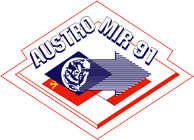From investigations on austronauts and laboratory animals, it is known that not only stays in space but also merely movement deficiencies can lead to changes in immune reactions. The weight of lymphatic organs decreases, lymphocytes are less active and less interferon is produced. These changes can be immediately shown in genetic material. Some damage can be recognized by cell enzymes and therefore repaired. If left unrepaired, they are a constant risk for the organism and can lead to cancer or much greater damage.
Genetic changes can lead to changes in the immune system. They attack cell metabolism as well as DNA formation. The lymphocytes are particulary endangered as the immune system plays a central and decisive role when later damage appears. The immune cells are affected in two ways. Firstly, they can change genetically themselves, probably increasing the infection-prone rate. Secondly, they are responsible for the defense against tumor formation and growth.
Objectives
The effects of stays in space on genetic material were investigated. Multiple blood samples where taken from the cosmonauts before, during and after the space flight. The cosmonaut himself had to take these samples during the flight. As these examinations had to be delivered quickly after recovery, active help from the Austrian embassy in Moscow, the Defense Ministry and Austrian Airlines managed to organize an air-bridge between Moscow and Vienna.
Results
Changes in the amount of natural killer cells (HK cells) could be clearly seen in the lymphocyte sub-population. While all other sub-populations (T cells, helper, suppressor and B cells) showed no changes during the space flight, the amount of NK cells fell backwards. Lymphocyte activity decreased already before the flight – probably under the effect of the training’s extreme conditions – and it reached a minimum after the flight. This result is based on the investigation of the interleucine-2-receptor-expression. The building of this receptor on the cell’s surface signalized the cell’s defense preparedness. The reduced ability to stimuli of the peripheral lymphocytes can be verified from the reduced DNA synthesis rate (doubling of the DNA before cell division). Normal levels where registered two weeks after the landing.
No significant changes could be registered in the spontaneous and induced sister chromatid exchanges (SCE) before and after the space flight. Interestingly, an increase in the SCE rate as the lymphocytes’ ability to stimulus decreased was observed at any given time on the reserve cosmonaut. SCE’s are a very sensitive indicator of genotoxic effects. They are activated only through very specific DNA modifiers. One can conclude that the genotoxic effect that activated an in increase in the SCE rate of the reserve cosmonaut is different than the effective factors during the space flight.
In the Austrian cosmonaut’s chromatin, that is, in the nucleus of existing genetic information, only a small amount of structural changes can be observed after the flight by comparison to a control person. The reduced sedimentation velocity of DNA indicates an augmented appearance of DNA chain breakup. An increased DNA repair synthesis could not be proven.
All in all, it can be concluded that the extreme conditions of space flight and the preceeding training lead to a limitation of man’s immune function. This results in a clear diminishment of natural killer cells and a reduced interleucine-2-receptor-expression after stimulating the lymphocytes. One must include, even though minimal, a genetic strain that can be proven using very sensitive methods after a short flight, and can be explained in further investigations.
Practical application
Application ranges
- Clinical medicine
- Ambulant checkup of the population
Application target
- Evaluation of the state of health of people in view on occupational activities, die mit chemical und physical strains in Zusammenhang stehen (to be associated with)
- Diagnostics of immunological and genetical troubles in the clinical practise
Direct interested institutions on the utilization of the experiment results
- Toxicological Institutes in Austria
- Occupational medicine Institutes
- General Accident Insurance Establishment, Vienna
- Clinical centers
Technical characteristics
For the experiment MIRGEN in the fore-front a developement of an own apparatur was not necessary.
For the taking of the blood-samples all needed medical and technical equipement were used as they are usable in every labor for blood examination and testing.
Experimenters
Dr. Helga Tuschl (project manager)
Rozika Kovac
Dr. Wolfgang Klein
Elisabeth Ott
all: Austrian Research Center Seibersdorf Ges.m.b.H., Seibersdorf
